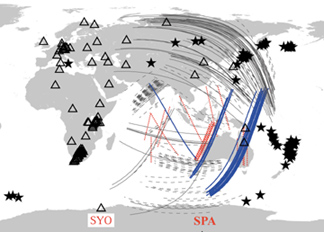 Researchers
look into Earth’s interior by measuring how fast and in what form seismic
waves travel from an earthquake, then through the mantle, the outer core, inner
core, back into the mantle and then through the crust to a seismograph. For
at least a decade, seismologists have known that the waves traveling north-south
through the inner core do so much faster than those traveling east-west —
so-called anisotropy. The telling data came from seismic waves that traveled
from earthquakes in the Sandwich Islands to seismographs in Alaska.
Researchers
look into Earth’s interior by measuring how fast and in what form seismic
waves travel from an earthquake, then through the mantle, the outer core, inner
core, back into the mantle and then through the crust to a seismograph. For
at least a decade, seismologists have known that the waves traveling north-south
through the inner core do so much faster than those traveling east-west —
so-called anisotropy. The telling data came from seismic waves that traveled
from earthquakes in the Sandwich Islands to seismographs in Alaska.This map of ray paths shows the travel time differences between waves that pass through the inner core and those that reflect off its boundary. Global and regional networks of seismometers measure how quickly the waves travel from their source, usually an earthquake. Circles indicate where those passing through traveled faster than reflecting from it, and triangles indicate where they traveled slower. The travel time differences vary between the western and eastern hemispheres, revealing that the inner core's structure is different on either side. Numbers mark different seismic networks. Courtesy of L. Wen, SUNY-Stony Brook
They have been working ever since to determine what this speed difference implies about the structure of the inner core. Recent work with new and refined data is showing that the strange behavior pervades the inner core, east and west.
Xinlei Sun and Xiaodong Song published work in the Feb. 19 online Geophysical Research Letters presenting evidence from shorter waves that bolsters their theory that the inner core is layered. In a 1998 paper in Science, Song, of the University of Illinois, and Donald Helmberger of the California Institute of Technology co-authored a paper proposing that the top layer was isotropic and the bottom layer anisotropic. “Previously, people assumed anisotropy is uniform,” Song says. In his Feb. 19 paper, Song says, “We’re seeing smaller, finer structures with the short-period data.”
Song’s 1998 study and recent work focus on the core’s western side, relying on the Sandwich Islands-Alaska waves. But even in 1998, Song and Helmberger suspected something was strange in the eastern hemisphere too. Their 1998 diagram of the possible inner layer did not show a perfectly round circle, but rather an uneven blob, allowing that the transition zone in the eastern hemisphere might be deeper.
That’s not to say that the outer core has varying regions of isotropy and anisotropy, says Lianxing Wen, a researcher at the State University of New York in Stony Brook. “We don’t see any evidence that this top 80 kilometers are anisotropic.” But even in this outer layer, “the eastern hemisphere is faster, and the western hemisphere is slower.” Wen and colleague Fenglin Niu published work in the April 26, 2001, Nature showing that waves passing through this upper layer traveled at different speeds beneath Asia and South America.
Adding to the mystery, Wen says, the waves traveling faster through the eastern hemisphere arrive at the endpoints with less energy. “This is counterintuitive.” And it eliminates temperature variations as the main cause of the hemispheric differences.
One possible cause, then, is structure — such as, Wen says, the presence of a melt pocket with an irregular shape and volume between hemispheres. “What is surprising for us is you have this hemisphere variation. We are also surprised that there could be differing fractions of melt between the two hemispheres.”
Kenneth Creager, a researcher at the University of Washington whose 1992 Nature paper generated discussion about the strange travel times of north-south waves, is also surprised at the difference between east and west. Another potential culprit, he says, is the alignment of the crystal structure in different parts of the core. Where the crystals are not well aligned, the waves travel slower. A well-aligned structure will send the waves through faster. “It looks like the western hemisphere is better aligned than the eastern hemisphere,” Creager says.
Also related is the mysterious boundary between the core and mantle. Waves traveling through this region have also thrown seismologists for a loop over the past decade. What’s going on at the core-mantle boundary could be affecting heat flow in the core, Wen says. Something is stabilizing the outer core’s temperature long enough for its structure to form differently than that of the lower core.
Waves that travel fast beneath the core-mantle boundary under Asia and slower at the boundary beneath the Pacific mirror their speed differences in the inner core, according to work being published in this month’s Geophysical Research Letters by Helmberger and co-authors Sheng-Nian Luo and Sidao Ni. The velocities could reveal connections in structure between the core-mantle boundary and inner core, they report. “The heat transfer out of the mantle is different underneath the Pacific than it is underneath Asia,” Helmberger says.
Kristina Bartlett

